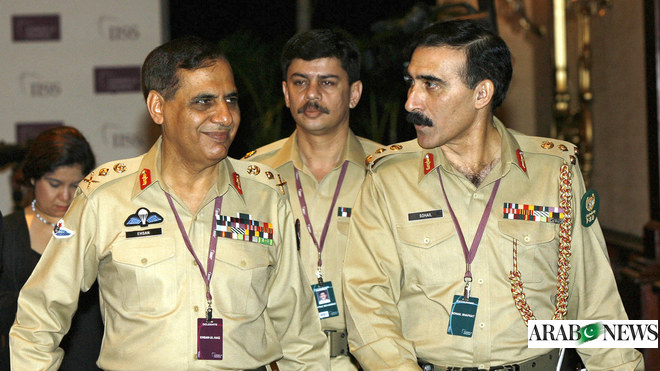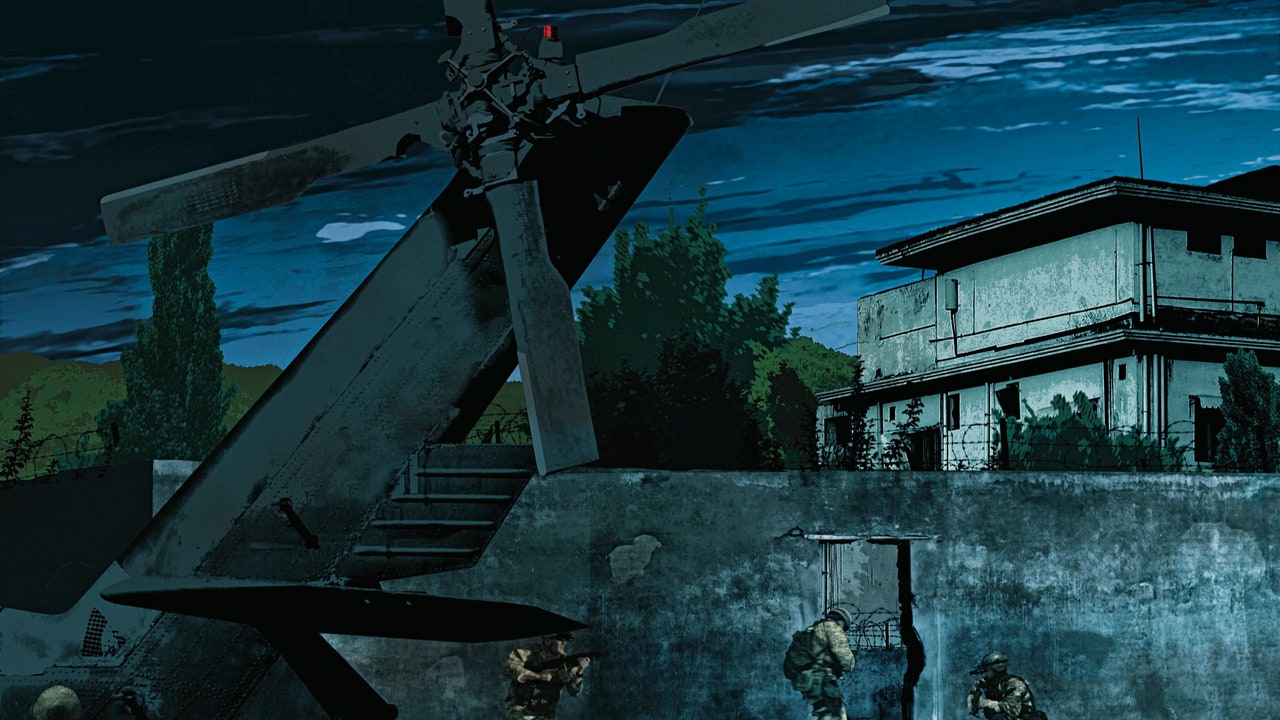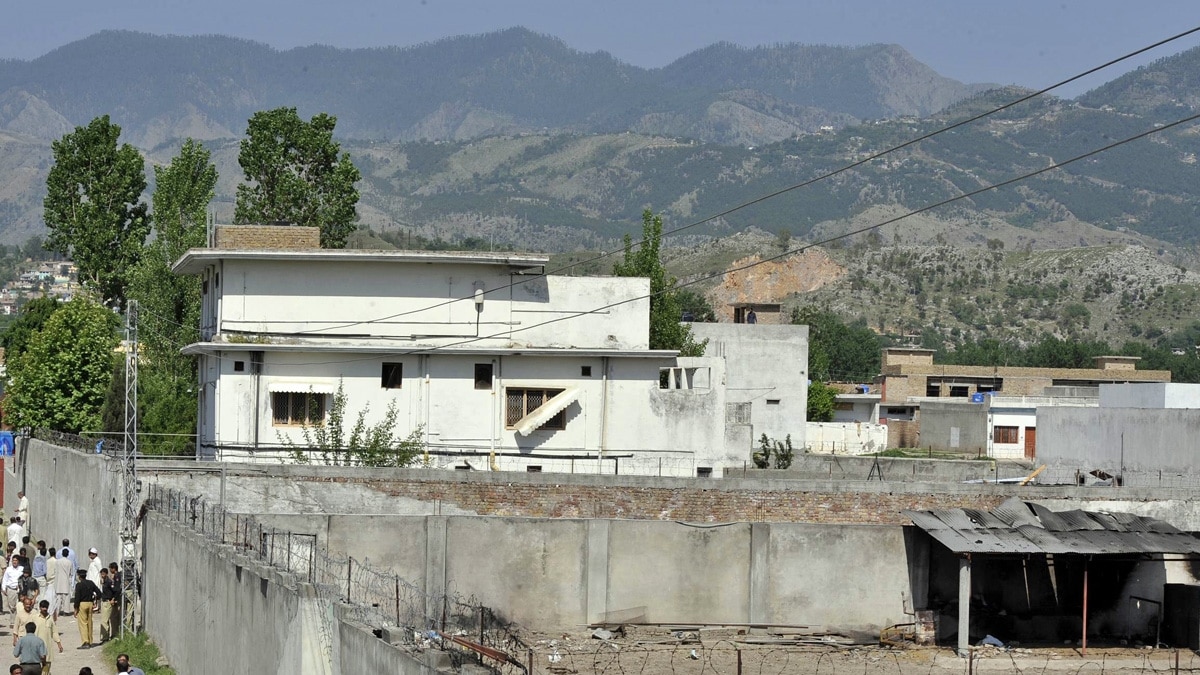Why is the title of the thread from the link posted in the OP in violation of PDF rules?
It merely discredits your effort to mislead all by itself.

Here is the whole article, and people should read ALL of it and undertand what it says before shooting off the hip:
==============================================
May 25, 2023
Current Issue
Image of the May 25, 2023 issue cover.
Sy Hersh and Osama bin Laden: The Right and the Wrong
Ahmed Rashid
Reviewed:
The Killing of Osama bin Laden
by Seymour M. Hersh
Verso, 132 pp., $19.95
On May 1, 2011, President Obama announced that Osama bin Laden had been killed in a “targeted operation” carried out by a “small team of Americans.” The raid was conducted, he explained, after “years of painstaking work by our intelligence community” had uncovered bin Laden’s hiding place in a compound in Abbottabad, Pakistan. Obama said the successful attack was “the most significant achievement to date in our nation’s effort to defeat al-Qaeda.”
During the past few years, the CIA’s claim to having successfully tracked down Osama bin Laden through extensive intelligence work has come under scrutiny by a small group of skeptics. Seymour Hersh, the widely admired investigative journalist who uncovered the My Lai massacre in 1969, is perhaps the most insistent and vocal among them. His own controversial account of how the CIA found and killed the founder of al-Qaeda originally appeared as “The Killing of Osama bin Laden” in the London Review of Books last May, and has now been published in a book of the same name, along with three other essays concerning US policy and Syria.
According to the US government’s official account, the CIA, through “painstaking work,” had identified a “courier” who delivered messages to bin Laden at a house in Abbottabad. Bin Laden and his family had been living there for several years, unknown to the Pakistani military’s Interservices Intelligence (ISI). The house had been especially built for the families of bin Laden, the courier, and the courier’s brother on land that the courier had personally bought. According to the US government, the CIA never informed the ISI of its discovery, nor did it inform it about the planned US Special Forces attack. The subsequent covert airborne raid by SEAL Team Six resulted in the death of bin Laden, bin Laden’s son, the courier, and the courier’s brother and brother’s wife. Bin Laden’s body was flown out in one of the helicopters and buried at sea within twenty-four hours, in keeping with Islamic custom.
When the story of bin Laden’s killing was made public, crowds of people gathered at the White House and Ground Zero to celebrate what was understood to be an American victory in the war on terror. The CIA was praised for its intelligence work, Obama for his decisiveness in authorizing the attack, and the US SEALs for their courage and success in carrying out the raid. Soon after the announcement, however, the official US account of what happened was called into question as new information was made public that contradicted the story initially told by the government. John Brennan, the deputy national security adviser, originally told reporters that bin Laden had “engaged in a firefight” with the US SEALs conducting the raid. A day later White House spokesman Jay Carney announced that bin Laden had not been armed. Two of the SEALs involved in the raid separately released contradictory accounts of what happened in Abbottabad, each claiming to have fired the final shots at bin Laden.
The shifting official account of what happened during, and leading up to, the Abbottabad raid quickly encouraged speculation that important parts of the story remained untold. In an article in The New York Times Magazine of May 12, 2015, Carlotta Gall described the story of bin Laden’s death as a “changeable feast.” “All of the accounts,” she suggested, “were incomplete in some way.” Hersh writes in his book’s first chapter that “the White House’s story might have been written by Lewis Carroll: would bin Laden, target of a massive international manhunt, really decide that a resort town forty miles from Islamabad would be the safest place to live and command al-Qaida’s operations?” Hersh’s incredulity led him to write his own account, for which he tells us he relies upon the testimony of a retired US senior intelligence official, two longtime consultants to the US Special Operations Command, and Pakistani insiders who are not named.
According to Hersh’s version, bin Laden was tracked down not by extensive CIA spying but by the evidence from a “walk-in”—a former Pakistani intelligence officer who came to the US embassy in Islamabad in August 2010 and told CIA officials that the ISI, Pakistan’s intelligence agency, had been keeping bin Laden in custody in Abbottabad since 2006. The compound, he said, was financed by the Saudis. After the US became aware of this information, Hersh writes, the ISI collaborated with the CIA to help plan and carry out the raid that would lead to bin Laden’s death. To prevent possible interference, the Pakistani air force was grounded during the raid and an ISI officer accompanied the American SEALs to direct them to bin Laden’s quarters. Hersh writes that bin Laden’s body was not buried at sea, as the American government insisted, but was instead thrown out of a US helicopter returning to Afghanistan.
The first part of Hersh’s account—his claim that bin Laden’s hiding place was revealed not by CIA spying but by a Pakistani informant—has been supported by Carlotta Gall, and Steve Coll, dean of the Columbia Graduate School of Journalism, has also suggested it is plausible. In her New York Times Magazine article in 2015, Gall reported learning from a high member of the ISI that “it was indeed a Pakistani Army brigadier—all the senior officers of the ISI are in the military—who told the CIA where Bin Laden was hiding, and that Bin Laden was living there with the knowledge and protection of the ISI.” Coll told Jonathan Mahler at The New York Times Magazine that he had been trying for four years to confirm the name of the informant.
The story of the brigadier, if true, would undermine both the CIA’s claim to responsibility for discovering bin Laden’s location and the Pakistani government’s denial of having known anything about it. But the supposed informant’s identity has not been verified. Steve Coll reiterated to me in an e-mail that neither he nor any other reporter he knows has yet been able to confirm it, although there have been rumors that he was taken to Washington, where the CIA continues to protect his identity. Coll also suggested that there has been so much speculation over the years about the possibility of an informant that it has become difficult to distinguish rumor from fact. Hersh’s own account relies largely upon the statements of an anonymous retired CIA officer. It seems possible (and this is my own speculation) that the revelations of a Pakistani walk-in coincided with the information supplied by the CIA’s own sources, whether in the bazaars of Pakistani cities or in the Pakistani bureaucracy. There may have been several routes along which information was reaching the CIA.
Hersh’s second major claim—that Pakistan’s military collaborated in the raid after the US discovered that it was hiding bin Laden—is not supported by the findings of Gall and Coll, and is the least likely aspect of his account. Hersh provides no historical analysis of the hugely complex and tense relationship between the US and Pakistani intelligence agencies. His only explanation for why the ISI would have cooperated with the CIA in killing bin Laden was “to ensure the continued release of American military aid, a good percentage of which was anti-terrorism funding that finances personal security such as bullet-proof limousines and security guards and housing for the ISI leadership.”
The relationship between the US and Pakistan has always been strained, and Hersh does not discuss the fact that 2011 was the worst year in US–Pakistan relations since the late 1980s. In December 2010, the US suspected that the ISI had deliberately leaked the name of the CIA station chief in Islamabad, who then became the target of so many death threats that the CIA had to remove him from his post in Pakistan. In January 2011, just four months before the death of bin Laden, US–Pakistan relations were suspended after Raymond Davis, a CIA contractor, shot two Pakistanis in Lahore. A third Pakistani was killed in a “hit and run” by the car that was coming to Davis’s aid. Davis was caught and jailed and the ISI refused to release him unless Washington issued a full apology, which the Obama administration refused to do, claiming that Davis had diplomatic immunity.
ISI–CIA relations sank further when Islamabad accused the CIA of stationing three hundred agents illegally in Pakistan and stopped issuing all visas for US officials wanting to visit Islamabad, including security guards for embassy staff. Fearing an attack by extremists, the entire US consulate in Lahore was shut down and moved to Islamabad.
Meanwhile, as the war in Afghanistan continued, Pakistan refused to exert pressure on both the Afghan Taliban and the Haqqani group to enter into talks with the Kabul regime, which carried out several attacks in Kabul. The mistrust between the US and Pakistan deepened after the US restarted drone attacks on Pakistani territory, conducting a total of seventy-five strikes during 2011.
Davis was finally released in late March—a few weeks before bin Laden’s death—after the US issued an apology, but the hatred and mistrust between the CIA and the ISI was acute. A day after Davis’s release, a series of US drone attacks in North Waziristan killed forty people—many of them civilians. General Ashfaq Kayani, the commander of Pakistan’s army, accused the CIA of “carelessly and callously” targeting “peaceful citizens.” In November the Pakistani army suspended all use of Pakistan’s roads by US and NATO military traffic into Afghanistan, in retaliation for the accidental killing of twenty-four Pakistani soldiers by NATO helicopters. The roads remained closed for seven months.
In view of the history of bad relations between the CIA and ISI during the period before the raid, it is inconceivable to me that the cooperation between them that Hersh describes could have taken place. That Hersh mentions none of these tensions and nothing at all about the state of CIA–ISI relations seems to me inexplicable. Moreover, in the aftermath of the Abbottabad raid, both the commanding general of the Pakistani army and senior ISI officers faced acute embarrassment and accusations from the civilian government, the parliament, the media, and the public. They were deemed incompetent for allowing US helicopters into Pakistani airspace. It is not plausible that military commanders would deliberately risk the kind of humiliation that Pakistan’s army then faced. Hersh does not mention any of this fallout.
As for US participation in the alleged cooperation, I cannot imagine that the administration, once it discovered bin Laden’s whereabouts, would so calmly accept that he had been kept hidden by Pakistan, with support from Saudi Arabia, since 2006. Wouldn’t the US have held these states accountable for the al-Qaeda attacks bin Laden may have planned during the time he was being looked after by Pakistan and the Saudis? Was the CIA, after spending two decades looking for bin Laden, suddenly going to start cooperating closely with the forces that had provided him sanctuary?
Finally, if the Pakistani military knew in advance about the US raid and had told everyone to stand down, dozens of senior Pakistani officers must have been informed. In Abbottabad alone, senior officers from the army, ISI, paramilitary, air force, the cadet college, police, civil bureaucracy, fire brigade, and dozens more would have to have been in on the plan in order to avoid any interference with the US raiders. Yet word of such a deal has never leaked out, and even the many sources of political gossip in Pakistan do not mention it.
The other three essays in Hersh’s book concern America’s policy in Syria and particularly President Obama’s surprising decision not to intervene after an extremely destructive chemical attack on the Damascus suburb of Ghouta in August 2013 was determined to have been conducted by the Assad regime. During the previous year, Obama had insisted that the Syrian government’s use of chemical weapons would be a “red line” and that there would be “enormous consequences” for violating it. Soon after the Assad regime was found responsible for the attack, Senate Majority Leader Harry Reid introduced a resolution that would allow the US to intervene militarily in the Syrian civil war. But in September, before any plans for American action had been put into effect, Obama canceled them altogether after Syria, with Russia’s prompting, agreed to destroy its entire chemical weapons arsenal.
This, at least, is the story that the US government tells; Hersh has a different version of what happened. He argues that the sarin attacks on Ghouta, which killed hundreds of people, were not carried out by President Bashar al-Assad’s forces as was widely believed at the time, but, with Turkey’s help, by Jabhat al-Nusra, a Syrian affiliate of al-Qaeda that opposes both the Assad regime and the Islamic State in Iraq and Syria (ISIS).
Hersh suspects that al-Nusra and Turkey conducted the chemical attack in order to provoke the US to intervene and punish the Syrian government. “Erdoğan’s hope,” Hersh writes, “was to instigate an event that would force the US to cross the red line.”
By 2013, there was certainly a strong belief in the Middle East that only US military intervention could bring the civil war in Syria to an end. Hersh’s claim that Turkey attempted to bring about such an intervention, however, is not adequately supported by other evidence or sources. In the absence of such evidence, it is hard to believe that Turkey’s involvement in a secret attack would not have been leaked, or publicly criticized, by some of President Erdoğan’s many opponents. It is equally doubtful that Erdoğan would have risked the damage to Turkey’s international standing, and his relations with major powers, if it became known that he was providing arms, including lethal gas, to al-Qaeda terrorists.
I’ve long admired the skill and independence with which Hersh has brought important and concealed information to light, and we can be sure there is no shortage of conspiracies to be revealed in a Muslim world torn apart by competing jihadist groups and by civil wars. But neither of the theories of secret conspiracy that Hersh presents in his book is backed up by strong evidence.
Even though so much of Hersh’s book relates to al-Qaeda and its affiliates, he gives us no sense of al-Qaeda’s position in the world in 2011 or today. Aside from the lack of evidence supporting his controversial claims, this is the most disappointing aspect of The Killing of Osama bin Laden. In recent years al-Qaeda has made a dramatic comeback. Since bin Laden’s death—which it has exploited to increase its standing in jihadist circles—its operations and attacks have been primarily carried out through partially autonomous franchises—al-Nusra in Syria, Ansar al-Sharia in Yemen, al-Qaeda in the Islamic Maghreb (AQIM) in Algeria, and al-Shabaab in Somalia. This more diffuse organization, with smaller affiliates commanding local loyalty in regions already caught up in civil war, has enabled the group to quietly expand its influence and survive the ascendancy of ISIS, an ascendancy that has recently been weakened.
AQIM, which has long been active across the Sahel deserts in Mali and Algeria, has now expanded its attacks to Burkina Faso and the Ivory Coast. Somalia’s deadly al-Shabaab—which pledged allegiance to al-Qaeda in 2012—has expanded its operations to Kenya. Al-Qaeda is regaining strength in the Arab heartland as some of its senior leaders return to Syria after years in exile in Pakistan and Afghanistan. This has enabled al-Nusra to challenge more effectively both the Assad regime and ISIS. From reports I have read, al-Nusra has been discussing the establishment of an al-Qaeda emirate or Islamic state in Syria that would openly challenge ISIS’s caliphate. In early May Hamza bin Laden, the twenty-four-year-old son of Osama bin Laden, called upon all groups in Syria to unite for “liberating Palestine”—a cause that is still popular among jihadists but largely ignored by ISIS. Moreover, the overall leader of al-Qaeda, Ayman al-Zawahiri, is still alive and apparently active while hiding out in the Pakistan–Afghanistan borderlands.
In Yemen, al-Qaeda in the Arabian Peninsula (AQAP) took control of and governed the province of Hadhramaut and its port of Mukalla for more than a year before being ousted in April by Yemeni regular forces. But AQAP is still active and has been trying to re- gain strength. According to US intelligence, it still maintains the capacity to bring down US aircraft and was responsible for last year’s attack on Charlie Hebdo in Paris. In Afghanistan al-Qaeda is working more and more closely with the Afghan Taliban and the Haqqani network. There are still over three hundred al-Qaeda fighters in Afghanistan, more in Pakistan, and a new affiliate that is active in India.
Relative to other Islamic groups, al-Qaeda has had the widest global impact on Muslims globally over the past three decades. Under the leadership of bin Laden, it elevated jihad to a primary and obligatory element of the Muslim faith (even though it is given no such status in the Koran or Hadith), and established an interpretation of jihad that encourages violence in the name of defending Islam against its enemies. Al-Qaeda’s understanding of and emphasis on jihad has been adopted by many subsequent Islamic groups, ISIS chief among them.
Unlike ISIS, al-Qaeda has taken a long-term approach to the project of building a new caliphate, with the conviction that it must first acquire the resources and popular base to sustain a new state. By contrast, ISIS started building the caliphate immediately and it is now taking serious military losses in Iraq and Syria while also running out of funds. However, what ISIS does retain and has used ruthlessly during the last year is a large cadre of fighters who are drawn from European states and have carried out multiple suicide attacks using various tactics in Germany, France, Belgium, and the US.
Whether or not Hersh’s theories are ever confirmed, it is important that we not allow them to distract us from the continuing dangers of al-Qaeda. While the American killing of Osama bin Laden had significant consequences, both practically and symbolically, for al-Qaeda’s status in the world, its effectiveness in limiting the organization’s power should not be overstated.
© 1963-2023 NYREV, Inc. All rights reserved.















